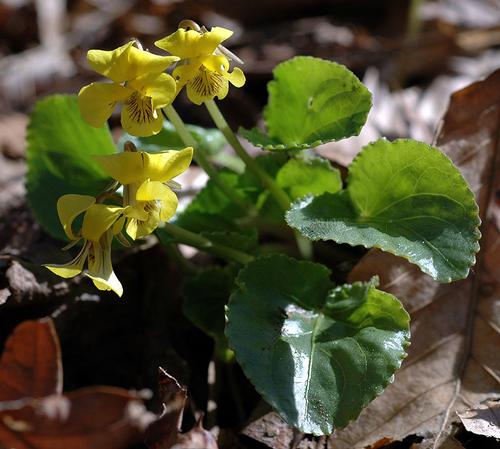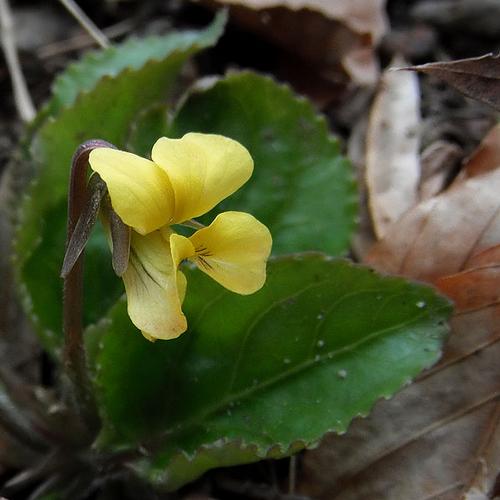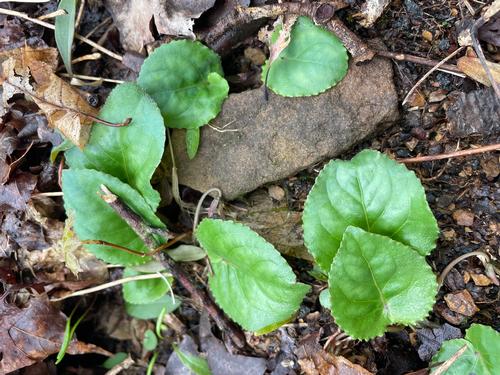Plants and Animals
Viola rotundifolia Round-leaved violet
Key Characteristics
This is the only acaulescent (i.e., stemless) yellow violet in Michigan, so flowering material will allow for ready identification. Leaves lie flat on the ground, are broadly ovate to broadly elliptic to orbicular, and have a narrowly cordate base, the basal lobes overlapping the petiole or even meeting one another.
The leaves become quite large with age, retaining pubescence even as they mature. The chasmogamous (i.e., flowers that open and cross-pollinate) yellow flowers are white-centered and held even with or just above the leaves. The plant also produces purplish cleistogamous (i.e., closed flowers that self-pollinate) flowers on leafless to single-leaved stolon-like stems.
Status and Rank
US Status: No Status/Not Listed
State Status: T - Threatened (legally protected)
Global Rank: G5 - Secure
State Rank: SNR - Not ranked
Occurrences
| County | Number of Occurrences | Year Last Observed |
|---|
Information is summarized from MNFI's database of rare species and community occurrences. Data may not reflect true distribution since much of the state has not been thoroughly surveyed.
Habitat
Michigan supports the western-most known population, disjunct from the nearest known other occurrences in southeastern Ontario and southern and northeastern Ohio. Its habitat is often montane, acidic, or rocky in cool, rich, hardwood or hemlock-hardwood forests. The only documented Michigan population is an open hardwood forest on high rolling, hilly terrain in Alger County. The population occurs mostly on exposed mineral soil on the downslope side of mature trees and on old root mounds.
Natural Community Types
For each species, lists of natural communities were derived from review of the nearly 6,500 element occurrences in the MNFI database, in addition to herbarium label data for some taxa. In most cases, at least one specimen record exists for each listed natural community. For certain taxa, especially poorly collected or extirpated species of prairie and savanna habitats, natural community lists were derived from inferences from collection sites and habitat preferences in immediately adjacent states (particularly Indiana and Illinois). Natural communities are not listed for those species documented only from altered or ruderal habitats in Michigan, especially for taxa that occur in a variety of habitats outside of the state.
Natural communities are not listed in order of frequency of occurrence, but are rather derived from the full set of natural communities, organized by Ecological Group. In many cases, the general habitat descriptions should provide greater clarity and direction to the surveyor. In future versions of the Rare Species Explorer, we hope to incorporate natural community fidelity ranks for each taxon.
Associated Plants
The sole Michigan record is associated with sedges (Carex communis, C. leptonervia), evergreen woodfern (Dryopteris intermedia), and Solomon-seal (Polygonatum biflorum).
Management Recommendations
Allow forests to mature and natural processes to operate unhindered. Maintain overstory and minimize development and fragmentation. When possible, leave large tracts of unharvested forests and allow natural processes (growth, senescence, wind throw, fire, disease, native insect infestation, etc) to operate unhindered. If forest is being managed for timber, minimize fragmentation, leave long periods of recuperation between harvests (50-70 yrs.), preserve as much area as possible in a forested matrix, and maintain a range of canopy closure comparable to pre-harvest closure.
Survey Methods
Random meander search covers areas that appear likely to have rare taxa, based on habitat and the judgment of the investigator.
-
Meander Search
-
Survey Period: From second week of April to fourth week of August
-
References
Survey References
- Elzinga, C.L., D.W. Salzer, and J.W. Willoughby. 1998. Measuring and Monitoring Plant Populations. The Nature Conservancy and Bureau of Land Management, Denver. BLM Technical Reference 1730-1. 477pp.
- Goff, G.F., G.A. Dawson, and J.J. Rochow. 1982. Site examination for Threatened and Endangered plant species. Environmental Management 6(4): 307-316
- Nelson, J.R. 1984. Rare Plant Field Survey Guidelines. In: J.P. Smith and R. York. Inventory of rare and endangered vascular plants of California. 3rd Ed. California Native Plant Society, Berkeley. 174pp.
- Nelson, J.R. 1986. Rare Plant Surveys: Techniques For Impact Assessment. Natural Areas Journal 5(3):18-30.
- Nelson, J.R. 1987. Rare Plant Surveys: Techniques for Impact Assessment. In: Conservation and management of rare and endangered plants. Ed. T.S. Elias. California Native Plant Society, Sacramento. 8pp.
Technical References
- Ballard, H. E. 2022. Viola rotundifolia. <https://people.ohio.edu/ballardh/vgpena/taxa/violarotundifolia.htm>. Accessed 15 October 2024.
- Ballard, H. E., J. T. Kartesz, M. Nishino. 2023. A taxonomic treatment of the violets (Violaceae) of the northeastern Unites States and adjacent Canada. Journal of the Torrey Botanical Society 150: 3–266.
- Kartesz, J. T. 2015. North American Plant Atlas. The Biota of North America Program (BONAP). Accessed 15 October 2024.
- Klaber, D. 1976. Violets of the United States. A. S. Barnes & Co., Inc., Cranbury, NJ.
- Little, R. J. and L. E. McKinney. 2015. Viola rotundifolia. Fumaria. In: Flora of North America Editorial Committee, eds. 1993+. Flora of North America North of Mexico. 19+ vols. New York and Oxford. Vol. 6, p. 155.
- Reznicek, A. A., E. G. Voss, and B. S. Walters. 2024. Michigan Flora Online. University of Michigan. <http://michiganflora.net>. Accessed 15 October 2024.
- Ruhfel, B. R. 2024. University of Michigan Herbarium. Personal communication.
- Weakley, A. S. and Southeastern Flora Team. 2024. Flora of the southeastern United States Web App. University of North Carolina Herbarium, North Carolina Botanical Garden, Chapel Hill, U.S.A. <https://fsus.6ncbg.unc.edu/show-taxon-detail.php?taxonid=323>.Accessed 15 October 2024.




